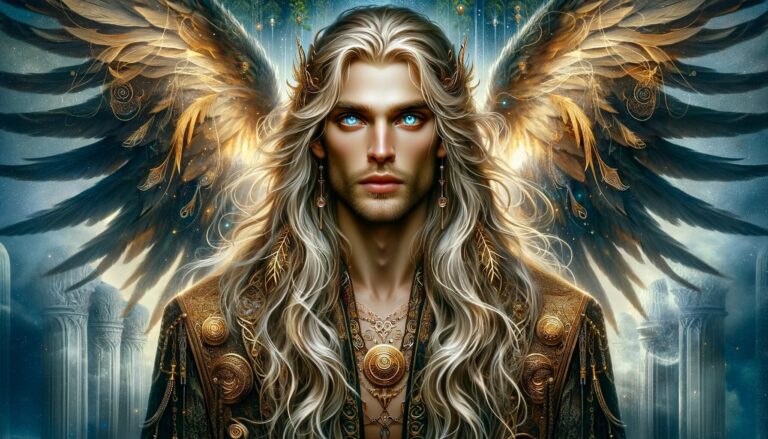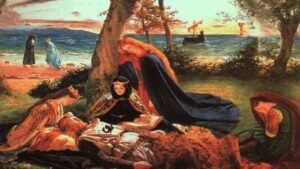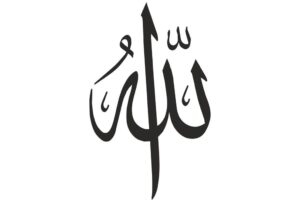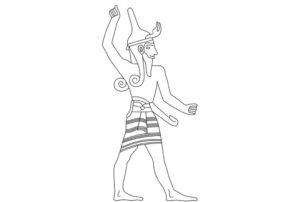Table of Contents
Mider, also known as Midir or Miach, is a fascinating and enigmatic figure from Celtic mythology. He is often described as a trickster deity, a lord of the Otherworld, and a master of magic.
Origins and Family
Mider’s origins are deeply rooted in Irish and Celtic mythology, where he is often associated with the Tuatha Dé Danann, a powerful race of supernatural beings who inhabited ancient Ireland. He is specifically linked to the House of Danu, the royal family of the Tuatha Dé Danann.
Mider’s family connections are complex and intriguing. Furthermore, he is sometimes depicted as the son of the goddess Ethniu and the grandson of Balor of the Evil Eye, a formidable and malevolent figure in Irish mythology. This lineage places Mider in a position of great importance within the supernatural hierarchy.
Appearance
Mider, the enigmatic Celtic deity, is often described as a tall and handsome figure with a captivating appearance. While specific physical details may vary across different sources and interpretations, there are some common characteristics associated with Mider’s appearance in Celtic mythology:
Tall and Handsome: Mider is typically depicted as a tall and strikingly handsome man. His physical allure is often highlighted in myths and stories, emphasizing his ability to charm and beguile those who encounter him.
Flowing Hair: He is often described as having long, flowing hair, which adds to his ethereal and otherworldly appearance. His hair may be depicted in various colors, ranging from golden to silver or even otherworldly shades.
Radiant Eyes: Mider’s eyes are often portrayed as radiant and mesmerizing, drawing people into his gaze. His eyes may be described as having an otherworldly glow, further emphasizing his supernatural nature.
Regal Attire: In some depictions, Mider is adorned in regal and resplendent attire; accordingly, this befits his status as a lord of the Otherworld. He may wear garments adorned with intricate patterns, jewels, and symbols of his magical prowess.
Wings: In certain interpretations, Mider is depicted with wings; consequently, this suggests his ability to move between the mortal realm and the Otherworld with ease. These wings symbolize his connection to the spiritual and supernatural dimensions.
Abilities
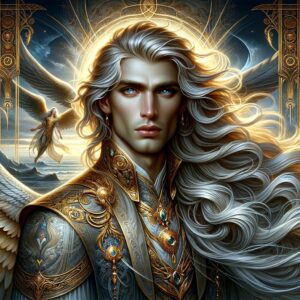
Mider’s abilities are a central aspect of his character. He is a master of magic, possessing a wide range of supernatural powers. Some of his notable abilities include:
Shape-shifting: Mider can change his form at will, assuming various guises to interact with humans and other beings.
Time manipulation: He is known to have control over time, allowing him to manipulate events and situations to his advantage.
Healing: Mider is often associated with healing and can restore health to those in need.
Illusion: He excels in creating illusions, deceiving and beguiling those who cross his path.
Mastery of the Otherworld: As a lord of the Otherworld, Mider can traverse between the mortal realm and the Otherworld with ease.
Weaknesses
While Mider possesses formidable abilities, he is not without weaknesses. One of his primary vulnerabilities is his susceptibility to the enchantments and charms of other magical beings. He can be ensnared by his own fascination with beauty and charm, which can lead to his involvement in various mythological conflicts.
Behavior with Humans
Mider’s interactions with humans are complex and often driven by his own desires and interests. Moreover, he is known for his amorous pursuits, frequently involving himself in romantic entanglements with mortal women. Additionally, his actions can have far-reaching consequences, as his relationships with humans are often tied to legendary events and tales of love, jealousy, and tragedy.
Mider is not always malevolent in his dealings with humans, and he has been known to aid individuals in need, providing healing and guidance. However, his capricious nature makes it difficult to predict his actions, and those who encounter him must tread carefully.
Symbols Representing Mider
Symbols associated with Mider are rich in meaning and often reflect his status as a powerful and enigmatic figure in Celtic mythology. Some of the symbols linked to Mider include:
The Otherworld Portal: Representing his ability to move between realms, this symbol is often depicted as a swirling portal or a gateway to the Otherworld.
Winged Serpent: The winged serpent symbolizes Mider’s connection to both the earthly and the Otherworldly realms, emphasizing his transformative abilities.
Cauldron of Regeneration: This symbol signifies Mider’s role in healing and rejuvenation, as he is often associated with cauldrons of magical brews that can restore life and vitality.
Trickster’s Mask: Reflecting his trickster nature, this symbol represents Mider’s penchant for deception and illusion.
Related Myths and Stories
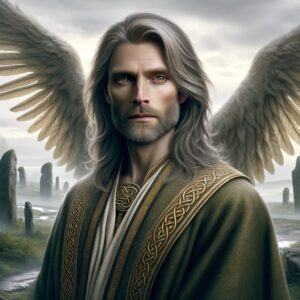
Mider features prominently in several myths and stories from Celtic mythology. Here are some of the most notable tales that involve him:
The Wooing of Etain
“The Wooing of Etain” is a captivating myth that centers on Mider’s relentless pursuit of the stunning mortal woman, Etain. Consequently, his unyielding determination to win her love sets in motion a series of events that have far-reaching consequences, including jealousy, transformation, and conflict among the Tuatha Dé Danann.
Long ago, in the realm of the Tuatha Dé Danann, Etain, with her unparalleled beauty, had captured the hearts of many mortals and supernatural beings alike. Among her ardent admirers was Mider, the enigmatic lord of the Otherworld; consequently, he was captivated by her radiant charm.
Mider’s infatuation with Etain was boundless, and he spared no effort in his pursuit of her. He showered her with gifts, composed songs of love, and wove intricate spells to win her heart. However, Etain was already married to Midir, another member of the Tuatha Dé Danann.
Jealousy and tension brewed within the divine realm as Mider’s relentless advances continued. Consequently, the conflict escalated, leading to a supernatural duel between Mider and Midir. As a result, the two engaged in a battle of wits and magical prowess, each striving to claim Etain’s love.
In a stunning twist, Mider’s enchantments temporarily transformed Etain into a pool of water, a worm, and a beautiful butterfly. These metamorphoses were a testament to his magical abilities and, furthermore, his unyielding desire to possess her.
The conflict over Etain’s affections eventually led to a resolution, with Midir regaining her love. Yet, the consequences of Mider’s pursuit continued to reverberate throughout the Tuatha Dé Danann, leaving scars of jealousy and rivalry.
The Healing of Nuada
Long ago, in the ancient realm of the Tuatha Dé Danann, King Nuada, a wise and noble ruler, found himself in a dire predicament. He had lost his arm in a fierce battle against their rivals, the Fomorians. This loss of his arm was not only a physical wound but also a blow to his kingship, as a king was required to be physically flawless to rule.
The Tuatha Dé Danann, recognizing the need to restore their king, turned to Mider, known for his mastery over the healing arts and his close connection to the Otherworld. Mider, with his innate knowledge of both the mortal and supernatural realms, accepted the formidable task.
With unwavering determination, Mider delved into the depths of his magical repertoire. Moreover, he channeled the ancient and mystical energies of the Otherworld, harnessing their potent healing properties. Through an intricate and mesmerizing ritual, he wove spells and incantations that defied mortal understanding.
As the ritual reached its zenith, a miraculous transformation occurred. Nuada’s lost arm began to regenerate, slowly but surely. The onlookers gasped in awe as flesh, bone, and sinew emerged, forming a perfect and flawless limb. It was a breathtaking testament to Mider’s unparalleled skill and the Otherworld’s profound healing capabilities.
Nuada, now whole once more, stood before his people with renewed strength and confidence. His miraculous recovery solidified the belief in the restorative power of the Otherworld and the indispensable role played by Mider in preserving the well-being of the Tuatha Dé Danann.
The Tragic Tale of Ailill and Etain

In the tragic tale of Ailill and Etain, Mider’s involvement in the lives of mortals leads to heart-wrenching outcomes. This story vividly illustrates the complex interplay between the mortal and supernatural realms.
Once, in the realm of the Tuatha Dé Danann, there lived a beautiful mortal woman named Etain. Her radiant beauty captured the attention of many, including Mider, the enigmatic lord of the Otherworld. Enchanted by her charm, Mider sought to win her affections, setting in motion a series of events that would alter the course of their lives.
Mider, with his mesmerizing allure and supernatural powers, wooed Etain away from her mortal husband, Ailill, a chieftain of the mortal world. This act of romantic entanglement triggered a devastating chain of events.
Ailill, consumed by jealousy and despair, confronted Mider in a fierce battle. However, Mider’s magical abilities proved overwhelming, and he emerged victorious. Ailill was banished, separated from his beloved wife, and Etain was left in the Otherworld, forever bound to Mider.
Time passed, and Etain longed for her mortal life and husband. Mider, moved by her yearning, used his powers to return her to the mortal realm, but with a cruel twist of fate. She was reborn as a mortal, with no memory of her past life.
In her new incarnation, Etain was discovered by Ailill, now aged and weary. He recognized her as his lost love, and their love rekindled. Yet, Mider’s influence endured. As Etain regained her memories, Ailill’s jealousy flared once more.
In a tragic climax, Ailill attempted to take Etain away from her new life, but Mider intervened, turning her into a beautiful butterfly. Ailill, in a last desperate act, tried to capture the butterfly, but it slipped through his grasp and soared into the sky, forever out of reach.
Other Creatures
While Mider is a unique figure in Celtic mythology, there are other mythical beings and creatures from various cultures that share some similarities with him in terms of abilities or appearances:
Leprechauns: These Irish fairies are known for their magical abilities and trickster nature, somewhat akin to Mider’s mischievous tendencies.
Shape-shifters: In various mythologies worldwide, shape-shifters possess the ability to change their forms, much like Mider. For instance, examples include the Kitsune from Japanese folklore and the Selkies from Celtic mythology.
Gods of the Otherworld: Deities like Hermes in Greek mythology and Odin in Norse mythology also have the power to move between realms and manipulate time, similar to Mider’s abilities.
FAQ
What is Mider's role in Irish mythology?
Mider's role varies depending on the specific myth or interpretation. In "The Wooing of Etain," he is portrayed as an Otherworldly being who becomes infatuated with Etain and seeks to win her love, sparking a series of magical events and conflicts.
Is Mider considered a hero or a villain in Irish mythology?
In "The Wooing of Etain," he is portrayed as a character driven by his desires, which can be seen as either heroic or antagonistic, depending on one's perspective.
What symbols or attributes are commonly associated with Mider?
Mider is often associated with the Otherworld, and in some depictions, he may have wings, symbolizing his ability to move between realms.
What are Mider's notable characteristics?
Mider is often depicted as a powerful and enigmatic figure with a deep connection to the Otherworld. He possesses magical abilities and is known for his determination and pursuit of his desires, particularly in the context of his love for Etain.
